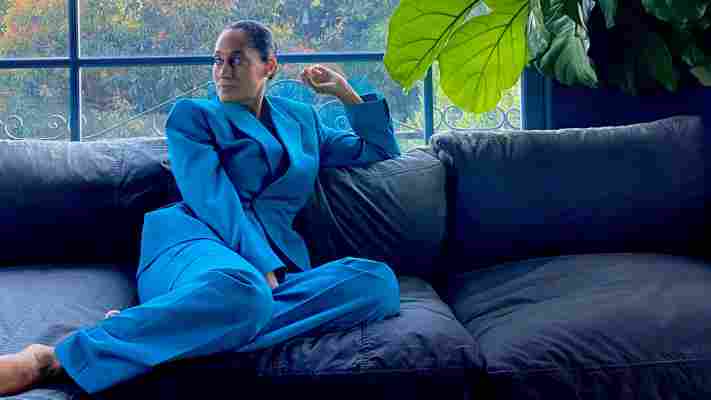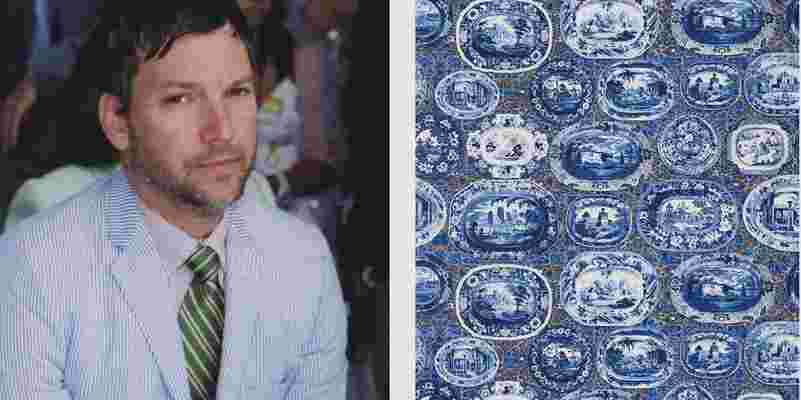28 Designer Decor Items to Put Your Fashion Sense on Display at Home
Photographed by Tracee Ross, Vogue, June/July 2020

Over the last couple of months, designer home decor has piqued my interest just as much as designer ready-to-wear and accessories. I’ve found myself swapping out the pillows on my couch just as often as I change the shoes on my feet. Instead of shopping for another chic coat to add to the closet this fall, I’m browsing dishware—perhaps it’s time I really cherish my plates and serving utensils, especially since I’m planning to prepare an epic meal this Thanksgiving. No matter how messy things may get in the kitchen, a set of Dior plates or a Tory Burch pitcher will keep things looking chic. After all, as interior designer Ariel Okin puts it, “taste translates from fashion to home quite seamlessly.”
It helps that several fashion brands have extended their aesthetic into home decor, from Ganni and Loewe’s chic candles to Louis Vuitton and Gucci’s glamorous accent furniture. Miss wearing your favorite floral Erdem frock? Invest in its bloom-adorned cashmere-blend blanket instead.
“If you tend to gravitate toward clean, sleek lines in your wardrobe, à la Phoebe Philo, channel that inspiration into nubby neutral fabrics, crisp upholstery, and minimalist artwork,” Okin recommends. If you lean towards a more traditional, day-out-in-the-countryside style, “infuse that cozy, homey vibe into your space with cushy roll arm sofas, sisal rugs, vintage paintings in brass frames, brown leather, and chinoiserie pots mixed in for good measure.”
“Ultimately, it’s not about copying any particular designer’s style—it’s about selecting the things that are true to your preferences and mixing them in a way that feels entirely and utterly you,” Okin adds. To help you get started, peruse 28 designer home decor items to uplift your space, below.
Top Fashion Designers Reveal What Interior Design Trends They're Loving Now
With New York Fashion Week just around the corner, everyone is awaiting the freshest spring trends for not only fashion but interior design. The dialogue between fashion and interior design is long established. Fashion's fast pace entices interior designers with design trends that transcend the medium and work in home decor as easily as on a runway. But fashion designers also tend to have a keen eye for interiors, and they often navigate both worlds. Take, for example, Johnson Hartig's new wallpaper and fabric collection with Schumacher or Bode's collaborations with Green River Project. Decorating trends and ideas also play a key role in developing a fashion brand's identity, from providing a visually stimulating backdrop for editorial shoots to the design of brick and-mortar stores. Case in point: the new fall ad campaigns for Michael Kors and CELINE set in gorgeous storied estates with interiors that enhance the provenance of the clothes.

We asked some of our favorite fashion designers to share their top picks for interiors trends in the coming seasons. What they're currently loving: bespoke details on everything from sofas to lamps, soft shades of pink, and statement furniture with feminine curves.
Basic Elements of Clothing Design
Clothing Patterns 101 Elements of Design
Basic Elements of Clothing Design
If you’ve always wanted to dabble in clothing design but thought you didn’t have the skill or the talent, I’m here to tell you:
You can do it!
If you sew your own clothes from commercial patterns you buy at the fabric store, you already make design decisions regarding style, color, fabric, and details. You make similar decisions when you shop, choosing the styles that have the details you want (that is, if you can find them!)
You can design your own clothes using the same fashion sense you use when you sew or when you shop - and you have total control over the results!
Elements of Design
The design details you’d use to distinguish your style include;
the shape of the neck and/or collar
the length, shape and fullness of sleeves (with or without cuffs)
the shape, length, and fullness of a skirt
the length, shape and fullness of a top or blouse.
By combining these elements in a "mix and match" fashion, you'll create an endless variety of styles - try a shawl collar with short sleeves, or bell sleeves and a V-neck top. These are simple variations on a basic blouse or top!
Darts and shaping seams can also be used as design elements – princess seams and shoulder or hip yokes are commonly used design details that also give the garment shape and fit. Pleats and gathers add fullness and movement. A slim cut skims the body and is more tailored. By “mixing and matching” various design elements, you can come up with an almost endless array of styles. Ease is the amount of extra fabric allowed for movement and/or style in a garment. Fitting ease (wearing ease) is the minimum amount of room needed for comfort and movement, usually 1 – 1 ½” more than the body measurement. Style ease (design ease) is additional ease added to achieve the desired style (such as a full skirt or a full sleeve, or an oversized silhouette).
Even the most basic dress can have a variety of looks, depending upon the style details you choose. For example, both of the dresses at left have the same silhouette - simple, fitted styles with a natural waistline. But the different colors, prints, and position of the bodice darts (side darts vs. neck darts) help create two entirely different looks. One has sleeves, one is sleeveless with contrast binding - you could add or remove sleeves on either dress for yet another new look.
Add flared skirts, full sleeves, or collars and you have an endless variety of fashions.
Shorten the body into a collection of tops and blouses and pair with skirts or pants - even more style options!
Simple elements, grouped together in varying combinations, are what clothing design is all about.
Learn more about the design process in Fundamentals of Apparel Design!
Finding Your Inspiration
To find inspiration for your designs, look to the past, to other cultures, or just to the latest fashion magazines.
Don't copy directly from another designer, especially if you plan on selling your creations. But focus on a detail that you love, and incorporate that into your design. It can be something as simple as the shape of a neckline, the drape of the bodice, the flare of the skirt - anything that catches your eye (it's bound to catch everyone else's eye in your garment, too!).
I love historic costume, but following a garment from the past feels too "costume-y" to me. I'll use the sleeve and neckline, or shape of the skirt, as inspiration for my own design.
I also love ethnic clothing, but again, want to avoid looking like I'm wearing a costume. Stitching or other decorative details can easily be incorporated into a simple top or dress.
For example, this is a 1920's 2-piece dress that inspires me. I like the wide neck and tapered sleeves, but I especially like the pleats at the left side and the low-slung belt. This is a kurta, which is a traditional men's tunic from India. It has a stand collar and regular shirt sleeves, but it also has the side pleats I like - and the asymmetrical hem is very modern.
Using the two styles above, I created 2 different tunics utilizing elements from BOTH styles.
The one on the left refers mostly to the men's kurta, but has the more feminine neckline and tapered sleeves taken from the 1920's dress.
The one on the right references the dress, it's been shortened to tunic length with the asymmetrical hem of the kurta. This necessitates raising the belt to the high hip, too.
Neither of the tunics I designed are copies, but both retain elements from the historic and ethnic originals.
How to Get Started
So, how to you start designing your own clothes?
Just start sketching! Browse through magazines, make a quick sketch when you see a celebrity wearing something you love, or make a note of a detail as you're watching a TV show or movie.
Then start putting those details together into a garment!
There will be a lot of trial and error - some design elements work well together, some don't - and don't try to put ALL your favorite details into one garment. It's overwhelming and you'll lose focus.
But all you have to do is sketch, sketch, sketch - keep trying different combinations until you find what you really like.
To help with your sketches, I have developed a sketch book, with figure templates (called "croquis") that will make it much easier to draw your styles with proper proportion, and depict movement. Creating a realistic sketch of your idea will help you visualize the style more fully.
The sketch book is available with misses or plus size croquis, and in a full-sheet size (8 1/2" x 11") or a smaller, purse size book
.
Click on the images, below, to go to the item in Amazon. As an Amazon Associate I earn from qualifying purchases. This helps to keep this site free for your use. You are free to search Amazon for these or other similar items without using the affiliate links on this page.
Misses Size Templates
Plus Size Templates Misses Size Templates, Small Book Plus Size Templates, Small Book
And add color!! Color can make or break a design. And a change of color - or color combinations - can create a whole new look for the same silhouette!
How can you get a grip on color? With coloring books! (yes, REALLY!!).
These fashion-inspired books, below, are a great start. Just grab some color pencils and go! It's only paper. You can't make a mistake! Try combinations that you think you'd never really wear. You'll be surprised at what works and what doesn't - and how much difference a change of color can make to any garment.
Click on the images, below, to go to the item in Amazon. As an Amazon Associate I earn from qualifying purchases. This helps to keep this site free for your use. You are free to search Amazon for these or other similar items without using the affiliate links on this page.
What's the Next Step?
Step-by-Step: Making and Fitting Your Block
Return to Clothing Patterns 101 Home Page
